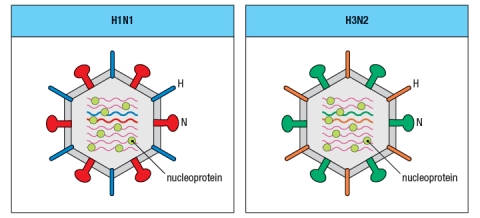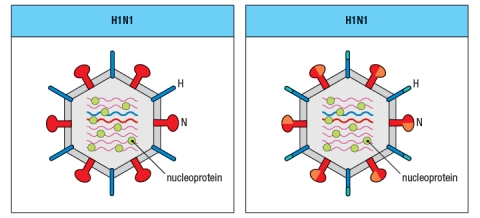Synthesis question: For the last five years, the seasonal flu vaccine has contained a mixture of two Influenza A strains and one Influenza B strain. The Influenza A strains were categorized as H1N1 and H3N2 subtypes. This nomenclature refers to the sequences of the two surface glycoproteins on the Influenza A virus particle, the hemaglutinin (H) and the neuraminidase (N). Antibodies specific for these glycoproteins are known to be effective at preventing flu infection. 
a) The highly pathogenic Asian avian flu causes a fatal infection in about 60% of the individuals infected. The seasonal flu vaccine does not provide protection against this strain of Influenza. Is the highly pathogenic Asian avian flu likely to be an H1N1 or H3N2 strain of influenza? Why or why not?
In the seasonal vaccine, the two strains of Influenza A, H1N1 and H3N2, are both required to provide protection to individuals exposed to one or the other of the viral strains. Currently, research efforts are focused on trying to generate protective CD8 T cell responses to Influenza A, with the goal of generating a 'universal' or broadly neutralizing vaccine that would provide protection against multiple strains of the virus, even those not included in the vaccine.
b) Based on the information provided in the cartoon of the two viral strains shown in Figure , what is the reasoning for expecting CD8 T cell responses to be protective against multiple different strains of Influenza A?
From year to year, the Influenza A strains circulating in the population undergo a process known as 'antigenic drift' in which mutations accumulate in the viral genes, leading to modest changes in the amino acid sequences of the viral proteins. Due to this antigenic drift, different isolates of the H1N1 or H3N2 strains are included in the annual flu vaccine. Shown in Figure are some of the regions of viral proteins that often undergo antigenic drift from year to year. 
c) What is the minimum number of amino acids that needs to change for a neutralizing antibody to the neuraminidase of the H1N1 strain on the left to no longer bind to the neuraminidase of the H1N1 strain on the right?
Correct Answer:
Verified
View Answer
Unlock this answer now
Get Access to more Verified Answers free of charge
Q18:
Q19: The antibody surface involved in antigen binding
Q20: Antibody heavy and light chain polypeptides consist
Q21: One striking feature of TCR interactions with
Q22:
Q23: The cellular distribution of MHC class I
Q24: Synthesis question: Several vaccines against viral infections
Q26: One strategy for vaccine development currently under
Q27: Hepatitis C is a virus that
Q28: T cells expressing
Unlock this Answer For Free Now!
View this answer and more for free by performing one of the following actions

Scan the QR code to install the App and get 2 free unlocks

Unlock quizzes for free by uploading documents